Sensory Processing Disorder (SPD) presents a distinct set of challenges for both the child experiencing it and the parents supporting them. A detailed guide, such as “Assisting Your Child With SPD: a Parent’s Manual to Sensory-Friendly Activities,” is invaluable in navigating these obstacles. The guide offers a variety of sensory-friendly activities specifically crafted to promote sensory integration and enhance the child’s interaction with their surroundings. Parents can significantly improve their child’s sensory development and overall well-being by incorporating these activities into daily routines. Let’s explore further how this guide can be valuable to SPD patients.
Key Takeaways
- Create sensory-friendly environments at home with minimal clutter, calming colors, and sensory-friendly furniture.
- Incorporate sensory activities into daily routines, such as sensory play, art projects, music sessions, and cooking activities.
- Use precise, predictable schedules and provide sensory breaks during outings to prevent sensory overload.
- Seek professional guidance from occupational therapists who can provide expert sensory activities for managing SPD at home.
- Resources such as sensory-friendly clothing brands and summer camps can provide additional support and sensory-friendly experiences for children with SPD.
Understanding Sensory Integration and SPD
Sensory IntegratIntegrationept, developed by A. Jean Ayres, is the cornerstone of understanding Sensory Processing Disorder (SPD). It centers on how our brain processes and organizes sensory information for motor and behavioral responses. This in-depth understanding is a foundation for fostering empathy and patience, which are essential when caring for children with SPD.
SPD manifests when children can’t effectively process sensory input. This disruption impacts motor skills, behavior, and social interactions. This reflects not a child’s will but a neurological condition requiring understanding, support, and intervention. Children with SPD may exhibit varied behaviors, such as hypersensitivity or hyposensitivity to sensory stimuli, which can be mistaken as signs of ADHD, highlighting the importance of proper identification and intervention of SPD and ADHD similarities.
Sensory systems encompass somatosensory systems, such as tactile, proprioceptive, and vestibular, and environmental systems, such as visual and auditory. Interoception provides information about our internal state. These specific sensory systems play a pivotal role in sensory processing and modulation, and understanding their functionality is critical when implementing supportive strategies for children with SPD.
In essence, by understanding the nature of Sensory Integration and SPD, we can better aid these children and create an environment that is supportive, understanding, and conducive to their growth and development.
Recognizing SPD Signs and Symptoms
Recognizing the signs and symptoms of Sensory Processing Disorder (SPD) is essential in supporting a child’s development and well-being. Children with SPD may show over- or under-reactivity to stimuli, affecting their behavior and social interactions, which are complex conditions. These indicators can vary from sensory-seeking behaviors to sensory aversions, and understanding them can assist in addressing sensory overload. Therapy for SPD, which includes occupational and speech therapy, focuses on aiding children in regulating their reactions to sensory input and enhancing their attention and focus. As we progress, we’ll discuss how to identify these signs and comprehend the implications of sensory overload, enabling you to support your child’s distinct sensory needs better.
Identifying SPD Indicators
Recognizing the signs and symptoms of Sensory Processing Disorder (SPD) is essential for early intervention in child development. As a parent or caregiver, it’s crucial to comprehend and pinpoint the diverse sensory cues that could indicate SPD in your child. These could appear in a range of sensory-seeking behaviors, reactions to overstimulation, or other specific SPD symptoms.
- Sensory-seeking behaviors: Children with SPD may exhibit a strong desire or aversion to particular sensory experiences. This could vary from an excessive need for movement to an extreme avoidance of touch. These uncommon reactions could be as subtle as fidgeting or as apparent as avoiding eye contact, which are fundamental indicators in infants of potential SPD.
- Overstimulation: In specific settings, these children may display signs of sensory overload, such as anxiety or irritability. A heightened sensitivity to sensory stimuli like light, sound, or touch often triggers this. Some children with SPD may demonstrate extreme reactions to minor environmental or routine changes, a symptom linked to this sensitivity.
- SPD symptoms: Watch for signs like poor coordination, difficulty adjusting to changes, or emotional dysregulation. These could be suggestive of SPD. Recall that early motor skill challenges, like struggling with rolling over or grasping objects, can also hint at sensory integration issues.
Understanding Sensory Overload
When a child with Sensory Processing Disorder (SPD) experiences sensory overload, the impact can be significant, leading to behaviors such as meltdowns, withdrawal, or avoidance of specific stimuli. This heightened sensitivity can manifest as discomfort or distress responding to ordinary noise, touch, or light levels. Shifts and routine changes may also be challenging. These signs indicate a child’s need for Pediatric Occupational Therapy, which can offer strategies and interventions to manage these sensory challenges.
Recognizing these signs is crucial for parents and caregivers to provide appropriate support. Symptoms may include irritability, restlessness, anxiety, or emotional dysregulation. These reactions are not intentional disobedience but rather the child’s attempt to cope with overwhelming sensory input.
Creating a sensory-friendly environment can help manage sensory overload. This involves reducing sensory triggers and introducing calming strategies tailored to the child’s needs, much like the individualized, play-based therapy plans used in Pediatric Occupational Therapy. The goal is to improve the child’s ability to engage in activities and daily routines without distress.
Understanding sensory overload in children with SPD is vital. It is about managing behaviors and acknowledging the child’s distinct sensory experience. With empathy, patience, and informed strategies, we can enable these children to navigate their world more comfortably.
Sensory-Friendly Resources and Support
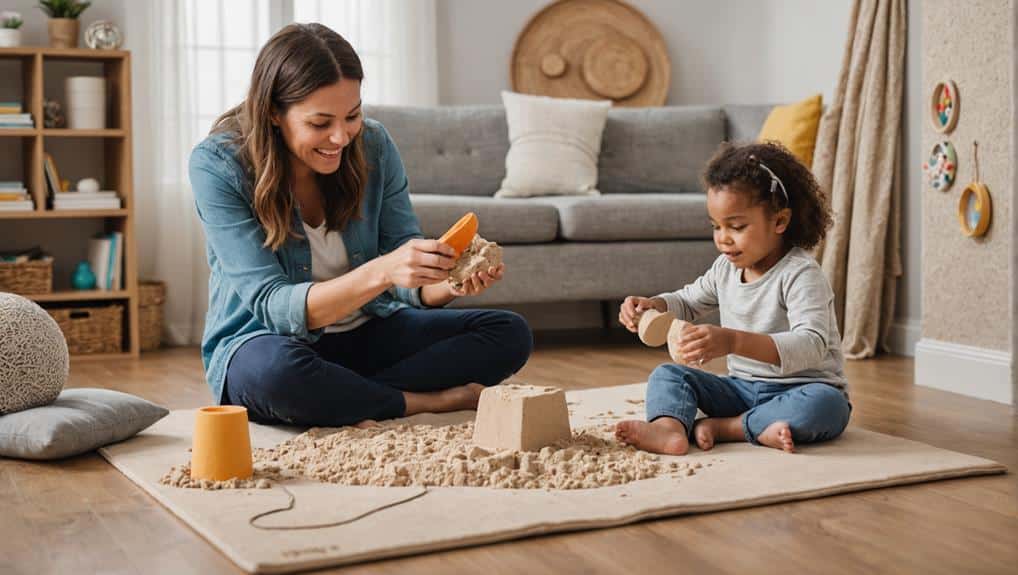
While venturing on the path of raising a child with sensory sensitivities, you may find an abundance of sensory-friendly resources and support to assist you. These resources include fact sheets that provide detailed information on Sensory Processing Disorder (SPD), signs, symptoms, and potential treatments. They serve as tools for parents, educators, and physicians to comprehend better and manage SPD. As part of early intervention strategies, occupational therapists can provide parents with expert sensory activities and tools to manage SPD at home.
Various resources are available to help you and your child navigate everyday life. These include:
- Lists of sensory-friendly clothing brands tailored to minimize discomfort and distress.
- Directories of summer camps that offer sensory-friendly activities, providing children with a safe and enjoyable environment.
- Downloadable resources are available in multiple languages, such as English, Portuguese, and Turkish, ensuring accessibility for diverse families.
These resources offer invaluable support to families dealing with SPD. They provide practical solutions, promote understanding, and foster community among families facing similar challenges. Remember, you are not alone in this expedition, and these resources are here to guide and assist you every step of the way.
Creating Sensory-Friendly Environments
Exploring the complexities of Sensory Processing Disorder (SPD) requires more than just knowledge and resources; it necessitates the creation of sensory-friendly environments. These spaces cater to children with SPD, minimizing triggers and providing calming sensory input, ultimately reducing stress and anxiety levels.
Sensory-friendly environments include soft lighting and quiet spaces, fostering a soothing atmosphere. This careful design allows your child to engage more comfortably in activities, helping them feel safe and secure.
Incorporating sensory-friendly materials is also vital. Fidget toys, for instance, can help children better regulate their sensory experiences. Weighted blankets, another valuable tool, can provide a comforting pressure that mimics a hug, calming an overstimulated child.
Creating sensory-friendly environments at home and in settings your child frequents is a proactive step towards helping them manage their SPD symptoms. Remember, the goal is to make your child feel secure and comfortable, enabling them to participate fully in activities. It’s about serving their needs, improving their well-being, and enhancing their overall quality of life.
Recommended Reading for SPD Parents
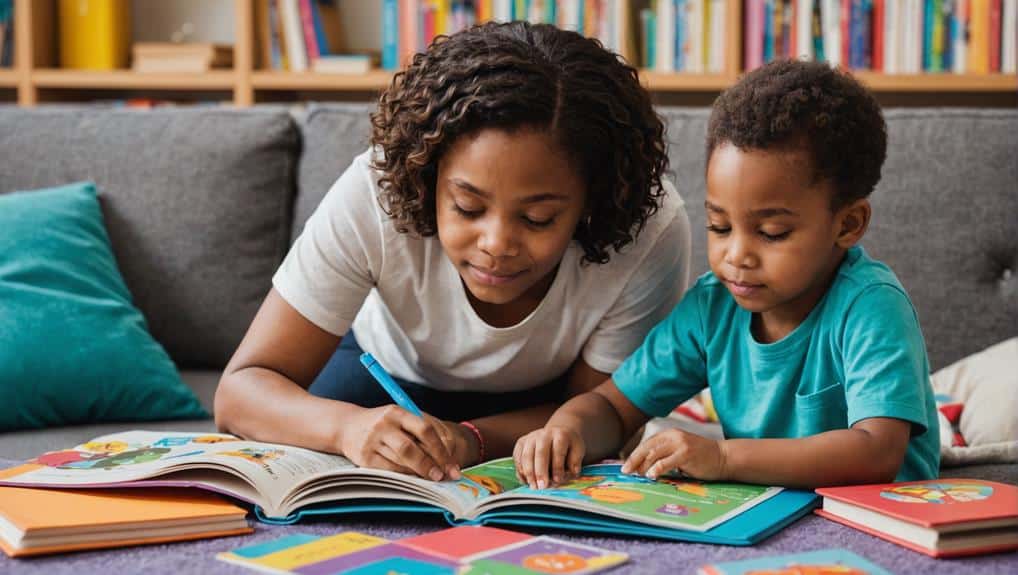
As parents of children with Sensory Processing Disorder, I know several authoritative books can provide invaluable insights and practical strategies for daily challenges. Titles such as “The Out-of-Sync Child”, “Growing Up with Sensory Issues”, and “Sensory Integration and the Child” come highly recommended for their in-depth approach to the subject. The following discussion will explore these crucial readings and how they can enrich your understanding and approach to sensory-friendly activities.
Essential SPD Parenting Books
Exploring the world of Sensory Processing Disorder (SPD) as a parent can be a demanding task. Gripping your child’s distinct sensory hurdles and aiding their growth requires knowledge, empathy, and patience. Thankfully, several books can help parents navigate this intricate terrain.
Here are three crucial SPD Parenting Books:
- “Sensory Integration and the Child” by A. Jean Ayres, PhD. This pioneering book offers in-depth insights into the science behind SPD and provides a strong foundation for comprehending your child’s sensory world.
- “Sensational Kids” by Lucy Jane Miller is a practical Parents’ Guide that skillfully combines scientific knowledge with real-life examples. It helps parents grasp and navigate sensory issues effectively.
- “The Out-of-Sync Child” by Carol Stock Kranowitz. This resourceful guide contains activities, tips, and strategies for helping your child conquer sensory challenges.
These books are invaluable tools in your SPD expedition. They provide the knowledge and strategies to aid your child’s development. Each book offers a distinct perspective on SPD, bringing you closer to understanding and effectively managing your child’s sensory challenges.
Insider Tips and Activities
Beyond the foundational knowledge offered by books like “Sensory Integration and the Child”, “Sensational Kids”, and “The Out-of-Sync Child”, there are more resources that provide practical, everyday guidance. “Growing Up with Sensory Issues” is a goldmine of insider tips and activities crafted to help parents navigate the world of Sensory Processing Disorder (SPD).
These resources offer invaluable insights into sensory integration challenges and practical strategies for creating sensory-friendly environments. By grasping and accommodating their child’s distinct sensory preferences and sensitivities, parents can promote positive sensory experiences. This proactive method can significantly alleviate daily challenges and enrich the child’s well-being.
Engaging in activities that cater to a child’s sensory needs is essential. The suggested books present many ideas, from calm reading time to energetic outdoor play, all tailored to meet varied sensory requirements. With these insider tips, parents can feel empowered and prepared to offer their children a supportive and empathetic environment, nurturing their growth and development despite SPD.
Parent Toolkit for SPD
Exploring the intricacies of Sensory Processing Disorder (SPD) can be a challenge for many parents, which is where the Parent Handbook for SPD proves to be an invaluable asset. This detailed guide offers valuable support and knowledge for parents navigating the world of SPD.
The handbook offers:
- Information on sensory processing issues and living with SPD enables parents to comprehend and empathize with their child’s experiences.
- Resources from The Spiral Foundation, a reputable organization well-known for its research and materials in sensory integration, include support contact information and copyright details, ensuring parents can confidently and legally utilize the resources within the handbook.
The Handbook for SPD covers sensory integration research, sensory processing challenges, and strategies for assisting children with SPD, providing a sensory-friendly manual for parents. It educates parents about the obstacles their child may encounter and equips them with the tools necessary to create an environment conducive to their child’s growth and development. The handbook is a tribute to parents’ dedication to their children, serving as a guiding light of understanding and support.
Sensory Systems: An Overview
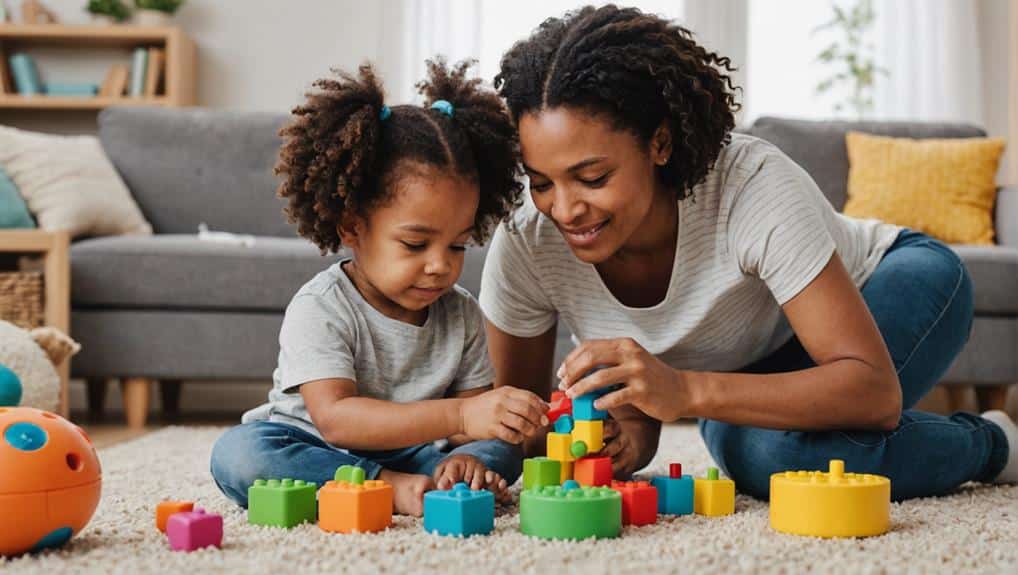
A child’s sensory systems, encompassing tactiHandbookrioceptive, vestibular, visual, and auditory inputs, lay the foundation for their daily functioning. These systems are the child’s gateway to the world, helping them process information from their environment and, importantly, leading to appropriate motor and behavioral responses.
Sensory modulation, a crucial function of these systems, regulates the child’s level of alertness, thereby impacting how they react to stimuli. A balance in sensory modulation is critical to effective sensory processing. When this balance is disrupted, children may experience sensory processing challenges, affecting their interaction with the world around them.
Each sensory system plays a distinct role in providing essential information about the world and regulating responses. For instance, proprioceptive inputs help children understand their body’s position in space, contributing to their motor skills and coordination.
Understanding these sensory systems is vital for parents and caregivers. It equips them to effectively identify and address sensory processing challenges in their child. With this knowledge, they can create a sensory-friendly environment that encourages their child’s growth and development. Remember, every child is unique, and so is their sensory experience.
Specific Sensory Systems: Tactile, Proprioception, Vestibular
Three specific systems play an important role in sensory development: the tactile, proprioception, and vestibular systems. Each one distinctly influences how children interact with their environment, impacting their perception of touch, body awareness, and balance. Understanding these sensory systems’ complexities can enable parents to offer suitable activities that enhance their child’s sensory well-being and general growth.
Understanding Tactile Sensitivity
Tactile sensitivity, a complex aspect of sensory processing, refers to a person’s heightened or diminished responses to touch input. This sensitivity can manifest in various ways and is often characterized by an aversion to certain textures or fabrics, leading to heartfelt or behavioral reactions.
As a parent, understanding your child’s tactile sensitivity can provide insights into their distinct sensory experiences. Here are a few key points to keep in mind:
- Tactile sensitivity can significantly impact daily life, affecting a child’s comfort with clothing, food textures, and intimate touch interactions.
- Desensitization techniques, such as slowly introducing different textures, can help manage tactile sensitivity. It’s vital to be patient and supportive during this process.
- Occupational therapy can be essential in addressing tactile sensitivity. Interventions focus on improving the child’s ability to process and respond to touch input.
Proprioception: Body Awareness
While tactile sensitivity relates to touch, proprioception is another equally crucial sensory domain. Proprioception is the sensory system that enables children to comprehend their body’s position and movements in space. This understanding provides the proprioceptive input needed to regulate muscle tone, coordinate movements, and maintain balance.
Children with proprioceptive challenges may seek intense sensory experiences or struggle with motor coordination. Recognizing and addressing these proprioceptive needs is essential to improving a child’s body awareness and sensory processing.
Activities that provide heavy work, deep pressure, and joint compressions can support proprioceptive input. These activities can offer the sensory stimulation children with proprioceptive difficulties often crave, helping them better understand their bodies and movements.
As a parent, understanding proprioception and its role in sensory processing can significantly impact your child’s life. Introducing proprioception-enhancing activities can nurture your child’s body awareness, improve motor coordination, and positively influence their sensory processing. Remember, every child is distinct, and what works for one might not work for another. Therefore, tailoring these activities to meet your child’s specific proprioceptive needs is vital.
Vestibular System’s Role
Given its critical role in balance and spatial orientation, the vestibular system significantly contributes to motor coordination and postural control. This system, primarily located in the inner ear, facilitates sensory integration. It’s susceptible to head position and movement changes, impacting alertness and calmness in individuals with sensory processing challenges.
- Receptors in the Inner Ear: The semicircular canals and otoliths are crucial for processing movement and head position information.
- Vestibular Input: Quick movements often have an alerting effect, while slow rhythmic movements can be soothing. Recognizing this can help tailor sensory-friendly activities to your child’s needs.
- Implications: Difficulty processing vestibular input can affect muscle tone, ocular motor control, and overall sensory regulation.
Understanding the vestibular system can help create effective strategies for managing sensory processing challenges. Remember, each child is distinctive, and what works for one might not work for another. Patience, empathy, and adaptability are crucial to finding the best sensory-friendly activities for your child.
Visual and Auditory Processing
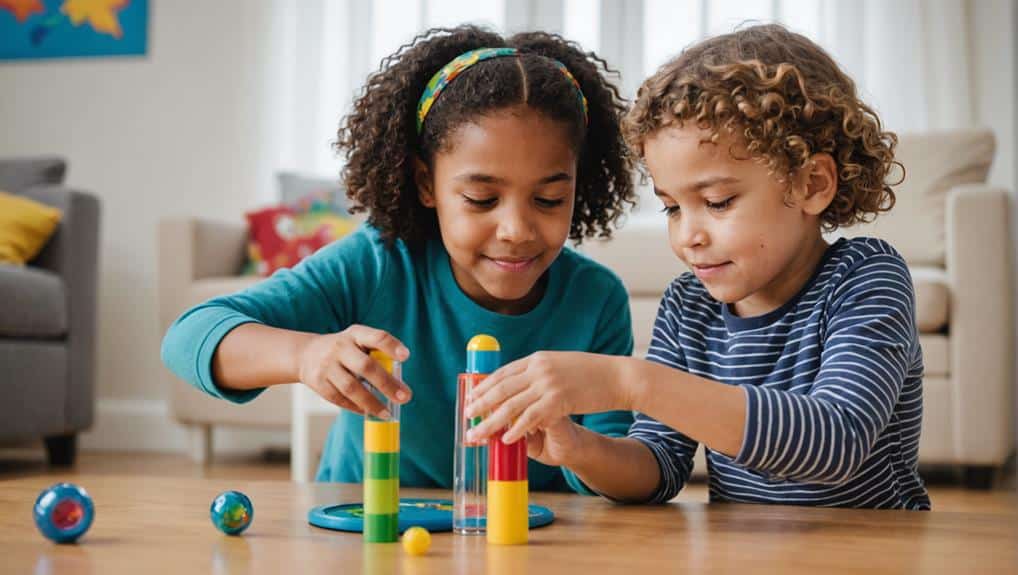
Children heavily depend on their visual and auditory processing skills when comprehending the world around them. Visual processing, involving the brain interpreting details like color, size, and brightness, is supported by the receptors in the retina. On the other hand, auditory processing assists in recognizing and understanding sounds in the surroundings, a vital auditory system function.
These crucial functions may be hypersensitive or hypersensitive for children facing sensory processing challenges. This can result in difficulties interpreting visual signals or differentiating sounds, leading to an overpowering sensory encounter. As caregivers, grasping these obstacles is the initial step in assisting.
Establishing sensory-friendly surroundings is a practical approach to supporting visual and auditory processing. Such environments reduce excessive stimulation and offer a peaceful setting for children to investigate. Incorporating specific activities that boost visual and auditory skills can also aid their growth.
Lastly, resources like noise-canceling headphones can be valuable for auditory processing. They can decrease background noise, enabling children to concentrate on significant sounds. Through these methods, we can assist children in navigating their sensory environment more effectively.
Strategies for Outings With SPD Kids
Venturing outside the home can often be challenging for children with Sensory Processing Disorder (SPD). The new environment and sensory sensitivities can cause discomfort and overwhelm. However, you can help your child navigate these outings smoothly with the right strategies.
- Clear Schedule: Give your child a predictable schedule before an outing. This reduces anxiety and sets expectations.
- Sensory Breaks and Kit: Incorporate sensory breaks into your outing to help your child manage their sensory challenges. Pack a sensory-friendly kit with items your child finds soothing or engaging.
- Exit Strategy: Always have an exit strategy planned. This provides a sense of security and reassurance that your child can leave the situation if it becomes overwhelming.
Sensory-Friendly Activities for Children

While children with Sensory Processing Disorder (SPD) may face difficulties in traditional settings, sensory-friendly activities are designed to accommodate and comfort them. These activities cater to the specific needs of these children, reducing sensory overload by featuring lower noise levels, softer lighting, and providing other sensory accommodations.
Sensory bright events are one example of sensory-friendly activities. They offer opportunities for kids with Sensory Processing Disorder to engage in enjoyable experiences with less sensory stimulation, helping the child feel more at ease. No-applause shows, for instance, create a calming atmosphere for children with sensory sensitivities, making them feel welcomed and understood.
Gradually introducing such activities can help children with SPD acclimate to new experiences. When the sensory input is regulated, the child feels more comfortable and less overwhelmed. As a result, they can feel joy and satisfaction in their activities. It’s essential to remember that every child is distinct, and what works for one may not work for another. A sensitive and thoughtful approach to introducing these activities can significantly impact the child’s life.
Seeking Professional Help and Parent Self-Care
Exploring the intricate realm of Sensory Processing Disorder requires a strong partnership with experts. As parents, seeking professional assistance is vital in addressing your child’s sensory processing challenges. Pediatricians, occupational therapists, speech therapists, and behavioral therapists know how to identify these challenges and offer appropriate interventions. Their guidance can pave the way for a more supportive setting for your child.
However, while these professionals play significant roles, parent self-care should not be ignored. As caregivers to children with SPD, you may find yourself physically and mentally drained. Remember, your well-being matters too. Consider these three steps:
- Educate yourself about sensory processing. This enhances your comprehension and ability to aid your child.
- Practice mindfulness and take the necessary breaks. This is essential for replenishing your energy and maintaining a clear perspective.
- Seek support from friends, family, or parent support groups. Sharing experiences and strategies can be incredibly beneficial.
Balancing expert help and self-care creates a harmonious setting for your child, nurturing their development while preserving your well-being. Remember, you are not alone in this voyage.
Frequently Asked Questions
How to Help a Child With SPD at Home?
To assist a child with SPD at home, create a sensory-friendly environment, provide activities that cater to their sensory needs, teach self-regulation techniques, and use visual aids to support daily routines and changes.
How to Calm Down a Child With Sensory Processing Disorder?
To calm a child with Sensory Processing Disorder, use deep pressure activities, slow rhythmic movements, sensory retreat spaces, sensory-friendly toys, and calming sensory activities like deep breathing exercises or gentle music.
How to Help a Sensory-Sensitive Child?
Understanding a sensory-sensitive child’s distinct sensory experiences is paramount to assisting them. Create a calming environment, offer suitable choices, foster open dialogue, and respect their boundaries. Your empathetic support can significantly ease their sensory challenges.
Can a Child With SPD Live a Normal Life?
A child with Sensory Processing Disorder (SPD) can lead an everyday life. With consistent support, understanding, and sensory-friendly strategies, these children can effectively engage in routine activities and social interactions like their peers.
Conclusion
Finally, enhancing one’s understanding of Sensory Processing Disorder, identifying its signs, and implementing sensory-friendly techniques can cultivate a supportive environment for children with SPD. This voyage may appear challenging, but the guide offers a guiding light of hope. The suggested activities, combined with expert assistance and self-nurturing, pave the way to a strengthened and enhanced life for children with SPD, reinforcing the saying that it is empowerment.

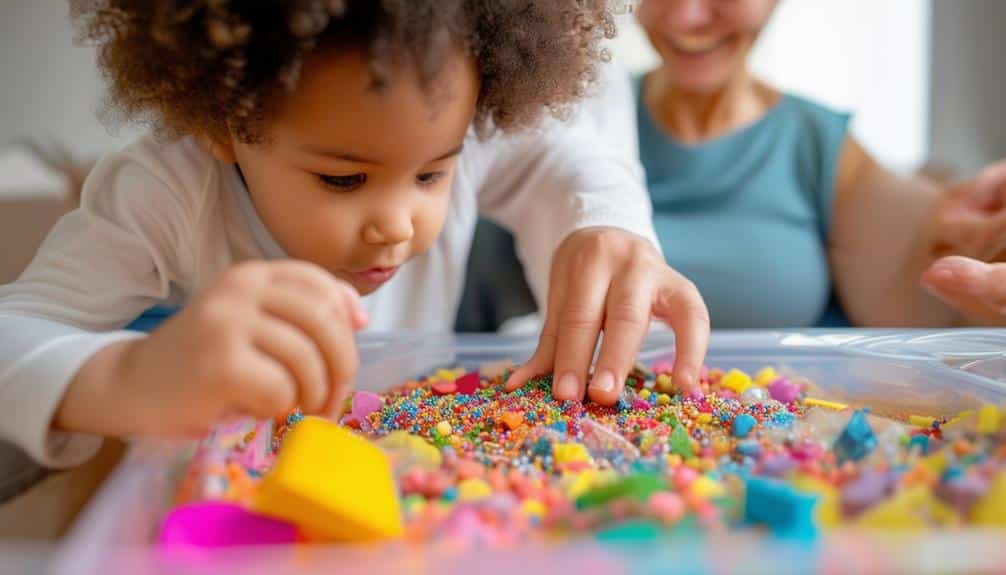
Recent Comments